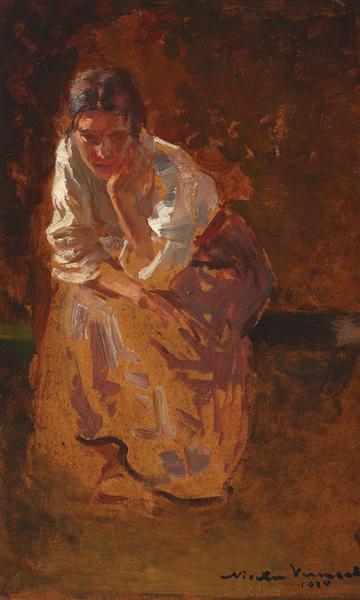Description
Nicolae Vermont's "thinking" (1924) is presented as a fascinating study of introspection and the inner life of the human being. Vermont, a prominent Romanian painter, is known for his style that often ranges between symbolism and realism, and this piece is no exception. The painting captures an intimate moment of reflection, representing with great emotional force the essence of human thought.
In the work, we observe a young man sitting in an environment that seems to be an interior simple. The composition stands out for its focus on the portrait of the main character, whose position reveals a deep contemplation. The young man is with his head inclined and his arms crossed on his knees, suggesting both vulnerability and concentration. Through this pose, Vermont manages to transmit a palpable sense of introspection and melancholy that invites the viewer to share the character's mental space.
The color plays a crucial role in the work, with a palette that evokes complex emotions. The dark tones predominate on stage, creating a notable contrast with the clarity of the young man's face. This choice of colors not only frames the character, but also reinforces the introspective atmosphere of the composition. The terrible nuances and the shadows that surround it build an almost dreamlike environment, where the exterior seems to dissolve in favor of inner life, highlighting the idea that thought can be a form of escapism.
The artist, through his loose and expressive style, manages to provide the young man with an almost tangible presence, while the details of the background remain vaguely outlined. This approach allows the viewer's attention to be concentrated in the character's emotional state, leaving aside external distractions that could interrupt this connection. The combination of a careful posture and the use of color not only enhance the psychological depth of the image, but also allow a broader reflection on the state of the human soul.
Nicolae Vermont, in his career, showed a continuous interest in the representation of the human being in his emotional complexity. Other works of his, such as the portraits of diverse figures, also reflect a similar psychological approach, where each brushstroke seeks to capture not only the external appearance, but the internal essence of their subjects. "Thinking" thus integrates in this area of art, where the individual is explored not as a mere visual object, but as a container of thoughts, feelings and experiences.
In the broadest context of the art of the early twentieth century, Vermont's work can be seen as an expression of the social and psychological changes that were occurring at the time, driven by political tensions and innovations in philosophical thinking. The figure that meditates in "thinking" could be seen as a symbol of the humanistic search for understanding and meaning in a constant change.
In conclusion, "thinking" by Nicolae Vermont is a work that invites contemplation. Through his mastery in the representation of the portrait and his poetic use of color, Vermont gives us a prolonged moment in the life of a young man caught in his thoughts. Painting is not only a reflection of the artist's ability to capture the essence of the human being, but also confronts us with our own relationship with thought and introspection. In a world where speed and distraction are constant, "thinking" reminds us of the importance of silence, reflection and inner search.
KUADROS ©, a famous paint on your wall.
Hand-made oil painting reproductions, with the quality of professional artists and the distinctive seal of KUADROS ©.
Art reproduction service with satisfaction guarantee. If you are not completely satisfied with the replica of your painting, we refund your money 100%.

